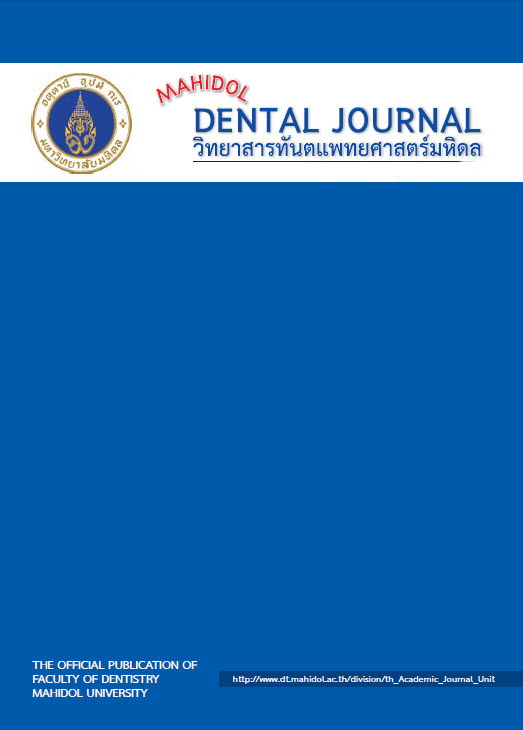Microleakage Of Class II Bulk-fill And Conventional Resin Composite Restorations With And Without Enamel Preservation At Gingival Wall
Main Article Content
Abstract
Objectives. This in vitro study tested the hypothesis that preserving a thin enamel layer at the gingival margin and using bulk-fill resin composites could minimize microleakage of class II resin composite.
Materials and Methods. Thirty-six human third molars were randomly divided into three groups of 12 specimens each: Filtek Bulk Fill Posterior Restorative in Capsules (BFC), Filtek Bulk Fill Posterior Restorative in Syringes (BFS) and Filtek Z350 XT (Z350). Teeth were prepared on two sides for a class II cavity (3 mm buccolingually x 2 mm mesiodistally at occlusal and 1.5 mm at coronal x 4 mm of axial depth) with 0.5 mm under the CEJ on one side (NP) and 0.5x1 mm of thin enamel at the gingival margin was preserved on the other side (EP). The teeth were then restored, thermocycled, immersed in 0.5% methylene blue solution for 24 hours and sectioned mesiodistally through the restorations. Dye penetration was evaluated at the gingival margin by three blinded examiners using a 0-4 ordinal scale. The Kruskal-Wallis test and Dunn test were used to compare differences in microleakage scores among the three restorative materials. Mann-Whitney U test was utilized to analyze the difference between enamel preserved (EP) and non-enamel preserved sides (NP) in the same restorative material. Tests were performed with the level of significance at a = 0.05.
Results. Mann-Whitney U test showed that the “NP” groups had significantly higher microleakage score than the “EP” groups. The Kruskal-Wallis test revealed significant differences in microleakage scores among the three restorative materials (P < 0.05). Compared to “Z350”, the “EP” group, “BFC” and “BFS” had significantly less microleakage score (P = 0.001) (P = 0.028). The “NE” group, “BFC” had significantly less microleakage score than “Z350” (P = 0.001).
Article Details
References
2. Opdam NJ, van de Sande FH, Bronkhorst E, Cenci MS, Bottenberg P, Pallesen U. Longevity of posterior composite restorations: a systematic review and meta-analysis. J Dent Res 2014;93:943-949.
3. Pallesen U, van Dijken JW, Halken J, Hallonsten AL, Hoigaard R. Longevity of posterior resin composite restorations in permanent teeth in Public Dental Health Service: a prospective 8 years follow up. J Dent 2013;41:297-306.
4. Brannstrom M, Vojinovic O. Response of the dental pulp to invasion of bacteria around three filling materials. ASDC J Dent Child 1976;43:83-89.
5. Retief DH. Do adhesives prevent microleakage? Int Dent J 1994;44:19-26.
6. Sarrett DC. Clinical challenges and the relevance of materials testing for posterior composite restorations. Dent Mater 2005;21:9-20.
7. Kidd EA. Microleakage: a review. J Dent 1976;4:199-206.
8. Leevailoj C, Cochran MA, Matis BA, Moore BK, Platt JA. Microleakage of posterior packable resin composites with and without flowable liners. Oper Dent 2001;26:302-307.
9. Fernandes CP, Chevitarese O. The orientation and direction of rods in dental enamel. The J Prosthet Dent 1991;65:793-800.
10. Oilo G, Jorgensen KD. Effect of bevelling on the occurrence of fractures in the enamel surrounding composite resin fillings. J Oral Rehabil 1977;4:305-309.
11. Van Ende A, De Munck J, Lise DP, Van Meerbeek B. Bulk-Fill Composites: A Review of the Current Literature. J Adhes Dent 2017;19:95-109.
12. Tiba A, Zeller GG, Estrich CG, Hong A. A laboratory evaluation of bulk-fill versus traditional multi-increment-fill resin-based composites. J Am Dent Assoc 2013;144:1182-1183.
13. Raskin A, D'Hoore W, Gonthier S, Degrange M, Dejou J. Reliability of in vitro microleakage tests: a literature review. J Adhes Dent 2001;3:295-308.
14. Chuang SF, Jin YT, Liu JK, Chang CH, Shieh DB. Influence of flowable composite lining thickness on Class II composite restorations. Oper Dent 2004;29:301-308.
15. De Munck J, Van Landuyt K, Peumans M, Poitevin A, Lambrechts P, Braem M, Van Meerbeek B. Critical review of the durability of adhesion to tooth tissue: methods and results. J Dent Res 2005;84:118-132.
16. Yavuz I, Aydin AH. New Method for Measurement of Surface Areas of Microleakage at the Primary Teeth by Biomolecule Characteristics of Methilene Blue. Biotechnol Biotec EQ 2005;19:181-187.
17. Alani AH, Toh CG. Detection of microleakage around dental restorations: a review. Oper Dent 1997;22:173-185.
18. Van Meerbeek B, De Munck J, Yoshida Y, Inoue S, Vargas M, Vijay P, Van Landuyt K, Lambrechts P, Vanherle G. Buonocore memorial lecture. Adhesion to enamel and dentin: current status and future challenges. Oper Dent 2003;28:215-235.
19. Tiba A, Zeller GG, Estrich CG, Hong A. A laboratory evaluation of bulk-fill versus traditional multi-increment-fill resin-based composites. J Am Dent Assoc 2013;144:1182-1183.
20. Zorzin J, Maier E, Harre S, Fey T, Belli R, Lohbauer U, Petschelt A, Taschner M. Bulk-fill resin composites: polymerization properties and extended light curing. Dent Mater 2015;31:293-301.
21. Hansen EK. Marginal porosity of light activated composites in relation to use of intermediate low-viscous resins. Scand J Dent Res 1984;92:148-155.
22. Furness A, Tadros MY, Looney SW, Rueggeberg FA. Effect of bulk/incremental fill on internal gap formation of bulk-fill composites. J Dent 2014;42:439-449.
23. Scotti N, Comba A, Gambino A, Paolino DS, Alovisi M, Pasqualini D, Berutti E. Microleakage at enamel and dentin margins with a bulk fills flowable resin. Eur J Dent 2014;8:1-8.
24. Webber MF, Marin GC, Saram P, Progiante LL, Marson FC. Bulk-fill resin-based composites: Microleakage of Class II restorations. JSCD 2014;2:15-19.
25. Mauro SJ, Durão VCA, Briso ALF, Sundefeld MLMM, Rahal V. Effect of different adhesive systems on microleakage in class II composite resin restorations. Int J Adhes Adhes 2012;34:6-10.
26. Franco EB, Gonzaga Lopes L, Lia Mondelli RF, da Silva e Souza MH Jr, Pereira Lauris JR. Effect of the cavity configuration factor on the marginal microleakage of esthetic restorative materials. Am J Dent 2003;16:211-214.
27. Raskin A, D'Hoore W, Gonthier S, Degrange M, Dejou J. Reliability of in vitro microleakage tests: a literature review. J Adhes Dent 2001;3:295-308.
28. Gale MS, Darvell BW. Thermal cycling procedures for laboratory testing of dental restorations. J Dent 1992;27:89-99.

